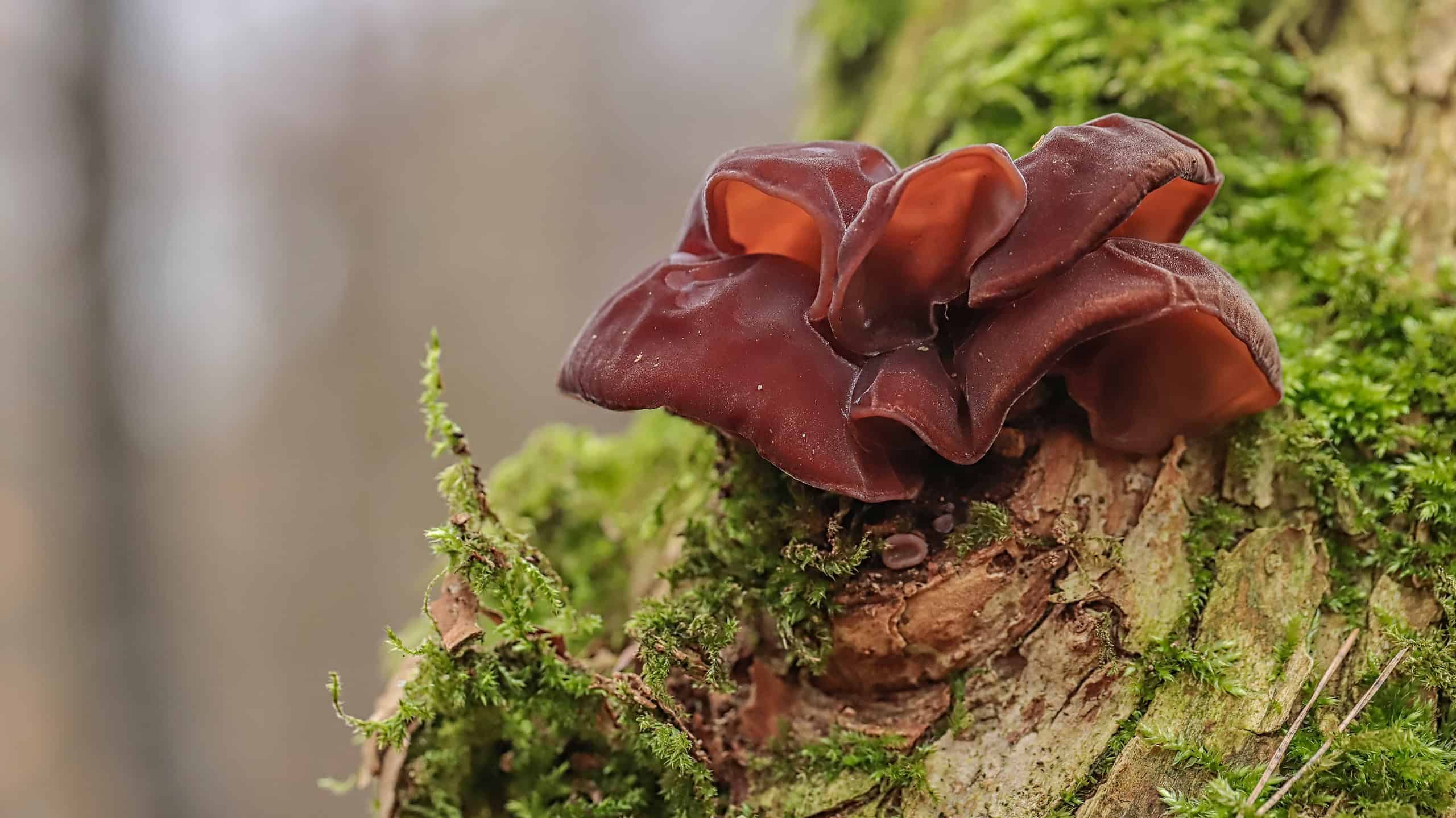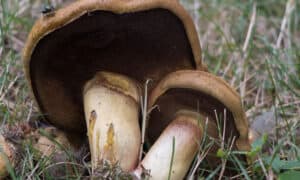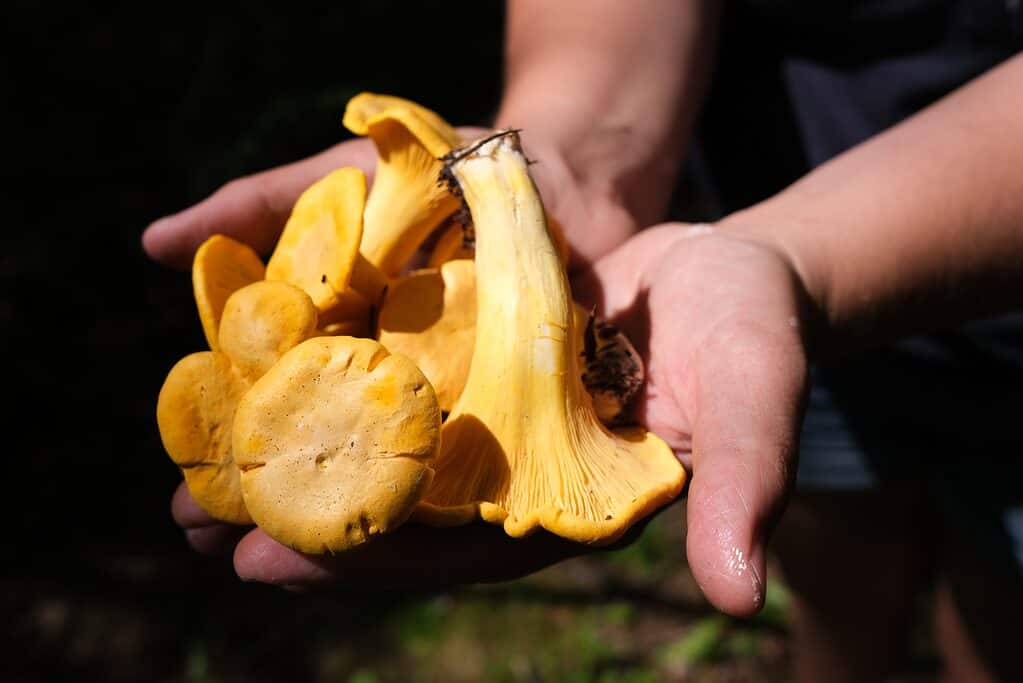
Just because it’s winter doesn’t mean it’s too late to find many kinds of wild mushrooms.
©Mathew Shawn Turner/Shutterstock.com
Believe it or not, you can actually forage for mushrooms in the wintertime! While it might be far too cold for some species, there are quite a few edible mushroom species out there that not only survive during the winter but are also at the prime stage for harvesting during the winter. There are many wild mushrooms found in winter that are completely edible and perfect for foraging.
In this article, we’ll take a look at 10 wild mushrooms found in winter that you can harvest even during the coldest months of the year.
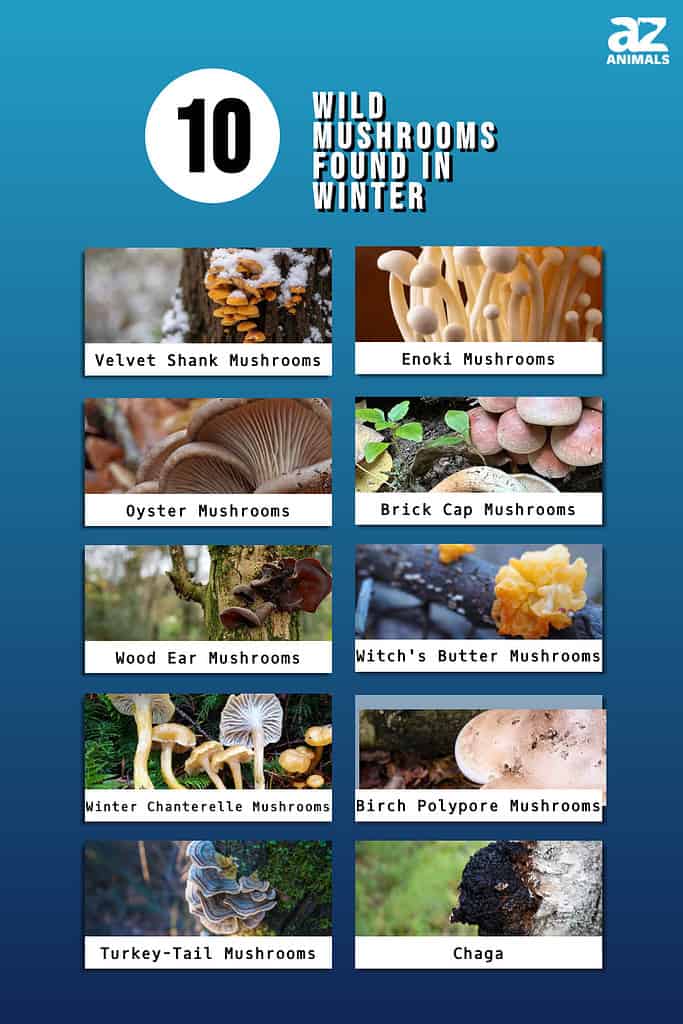
1. Velvet Shank Mushrooms
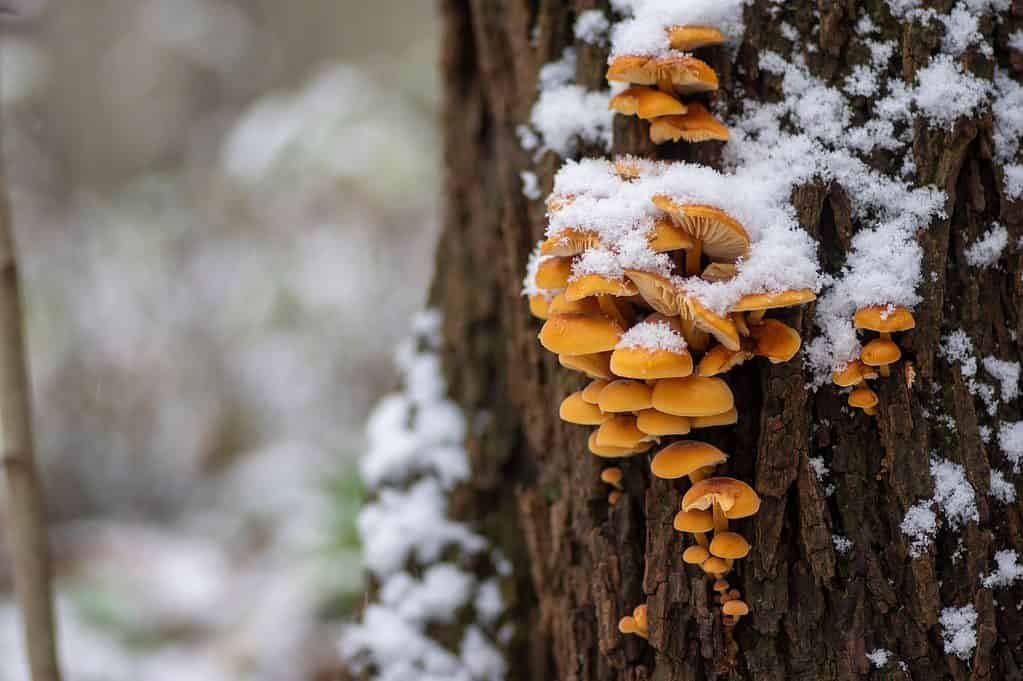
Velvet shank mushrooms (pictured) can handle very cold temperatures and even snow.
©Iva Vagnerova/Shutterstock.com
Velvet shank mushrooms are the common name for the species Flammulina velutipes. The flat and somewhat greasy orange cap, the pale yellowish gills, and the lustrous and velvety black stem are all characteristics of a velvet shank.
One of the few edible winter mushrooms is the velvet shank. As long as temperatures are above freezing, it may be spotted as early as September, although it is most prevalent in November and up until April. It does, however, endure brief periods of frost. On several different species of deciduous trees, velvet shank develops in compact clusters.
Although edible, velvet shank has no distinct flavor. The limited options that are otherwise accessible throughout the winter provide the majority of its validity as an edible fungus. The rough stem portion of the mushroom is usually cut off before it is cooked. It should be stated that this is not a beginner mushroom as the deadly galerina can look quite similar.
2. Enoki Mushrooms
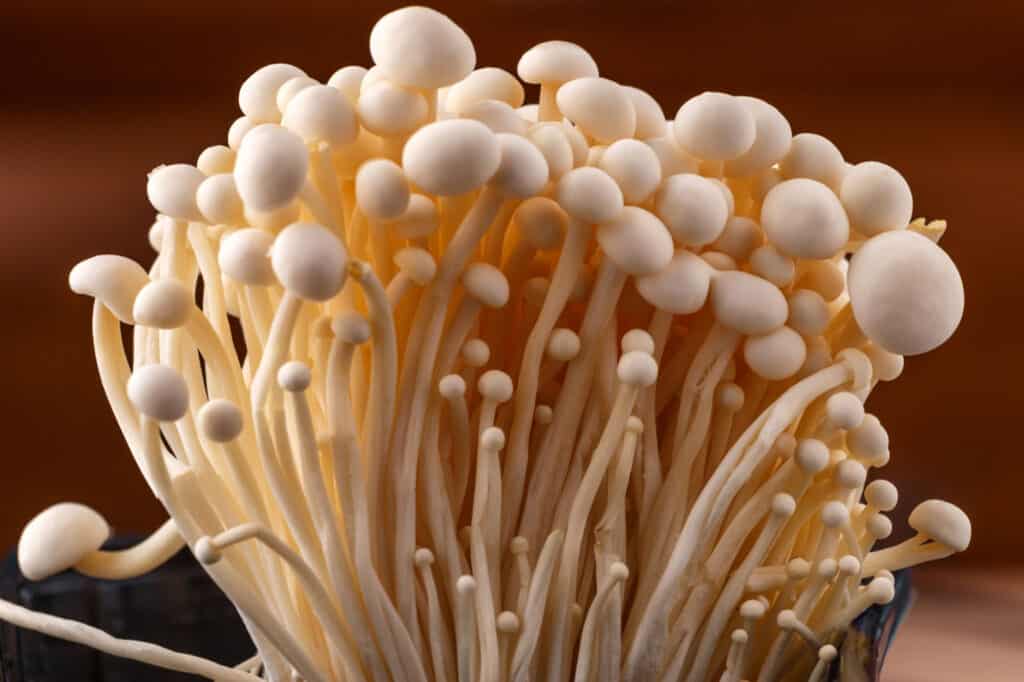
This is what enoki looks like when you grow them at home.
©Tamakhin Mykhailo/Shutterstock.com
Sister species and pretty much identical to the mushroom mentioned above is the enoki or enoki-take mushroom, also known as Flammulina filiformis. The velvet shank is known as the wild form of the popular enoki mushroom, but there are some distinctions worth noting. Since the cultivated variety is produced in a particular environment to promote the long, delicate stems desired in Japanese cuisine, velvet shank differ slightly in appearance from cultivated enoki mushrooms. But it’s purely aesthetic, and they taste essentially the same as farmed enoki.
Enoki mushrooms are widespread, difficult to recognize, and popular throughout the winter since they are readily accessible. Enoki mushrooms occasionally appear out of the snow in the spring, and you can find them even on the East Coast as late as early January. They flourish all winter in regions of Europe and the mid-Atlantic with warmer weather. They frequently grow on dead hardwoods, such as willow trees.
3. Oyster Mushrooms
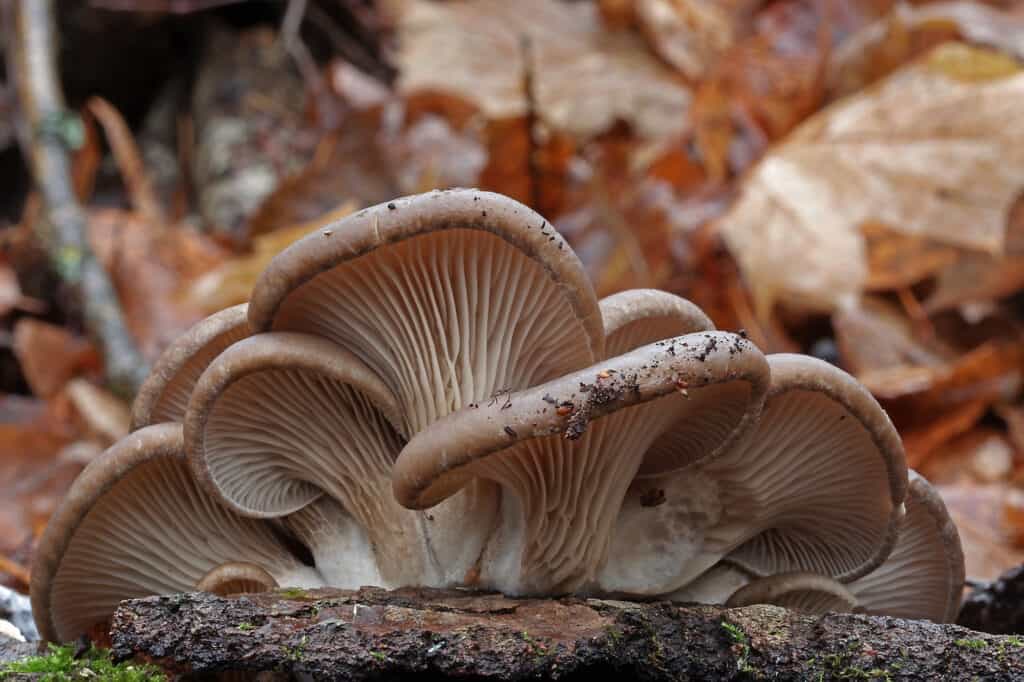
Oyster mushrooms (pictured) are known for their hardiness and can be found at various development stages during winter.
©NK-55/Shutterstock.com
Pleurotus ostreatus is more commonly known as the oyster mushroom. Both in terms of form and color, this mushroom can resemble an oyster. This species of oyster mushroom can range in color from blue-gray to cream. The cultured oyster mushrooms you may get at the grocery store are frequently white. The cap may get up to seven inches broad. Oyster mushrooms have a short, white stem. Additionally white, the gills extend quite far down the stem also known as decurrent. Oyster mushrooms are a wonderful starter mushroom since there aren’t any extremely toxic look alikes.
A typical edible wild fungus that grows from October to April is the oyster mushroom. On dead or partially dead tree trunks, oyster mushrooms can be seen growing, and you can frequently discover a large number of them in the same area.
There are several methods to prepare oyster mushrooms. The mushroom is good for drying as well as freezing. Since the oyster mushroom has a relatively neutral flavor, it may be utilized in a variety of recipes.
4. Brick Cap Mushrooms

A beautiful detailed pic of brick cap mushrooms
©Credit given to Brian Hunt aka hills47448 / CC-BY 4.0 https://creativecommons.org/licenses/by/4.0/ https://www.inaturalist.org/observations/139139501 – Original / License
Brick cap mushrooms, aka Hypholoma lateritium, are another great mushroom that can be found in winter. Due to its somewhat plain appearance and mild flavor, the brick cap mushroom is an edible fungus that is frequently disregarded. Even while it’s not a premier edible species that will blow you away with flavor, it’s nonetheless rather tasty. They grow in big groups and provide a stew or soup with wonderful volume, texture, and substance. This is another mushroom that we don’t recommend for beginners as the very similar-looking sulphur tuft aka Hypholoma fasciculare is known to be toxic. Also, some people could possibly mistake this for a deadly galerina as well, which can be lethal.
Brick cap mushrooms begin to grow in the fall and continue to bear fruit until the first frosts or snowfalls. The rotting and dead hardwood serves as food for the saprobic brick cap. They typically sprout out of old stumps and logs that have fallen. Despite growing all around the world, the brick cap mushroom is most prevalent east of the Rocky Mountains in the U.S.
5. Wood Ear Mushrooms
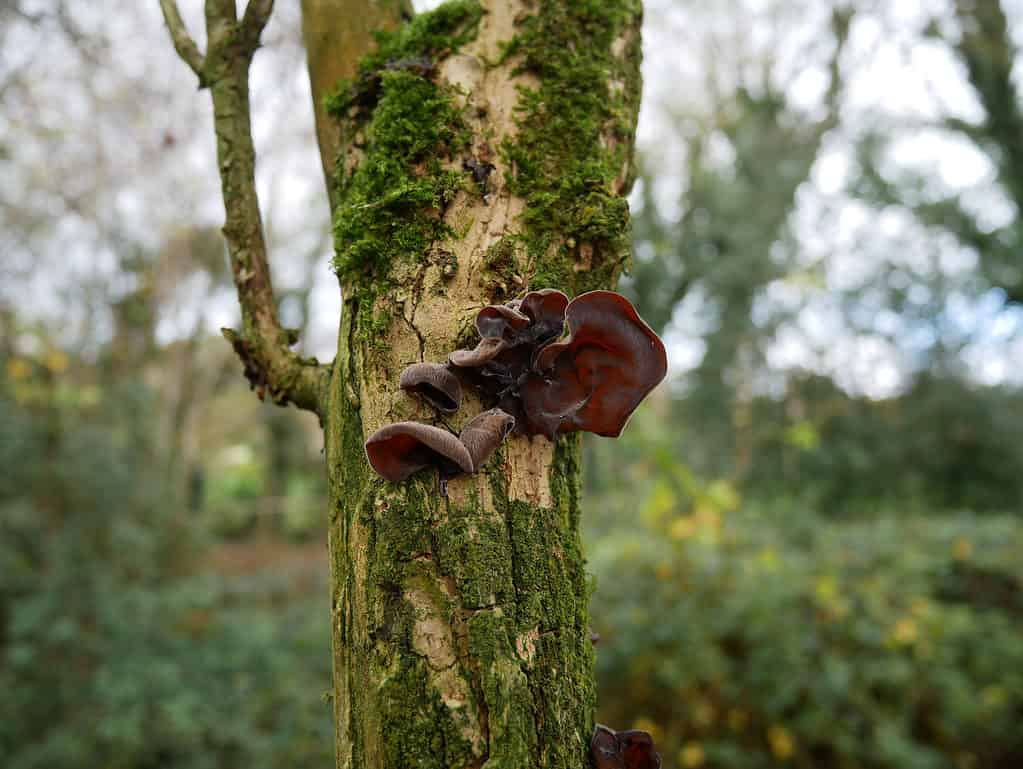
Wood ear mushrooms (pictured) have high water content and are more gelatinous than many other mushrooms.
©Brapaceae/Shutterstock.com
Wood ear mushrooms go by a number of different species. You will probably find most guides use the name Auricularia auricula-judae or Auricularia americana. You can find these mushrooms looking relatively ear shaped! They are kind of like small brown jelly blobs that may be attached together at a central point. It has neither a distinct flavor nor aroma. It is mostly found on old and dead tree trunks from September to March. Wood ear mushrooms can grow from many different kinds of trees. Since this mushroom is equally delicate to frost, warmer climates make it simpler to locate them in the winter. Most of the year, the wood ear may be found in wet, frost-free conditions.
The high water content of the wood ear mushroom prevents it from being cooked easily because it causes it to bounce on the pan. However, it may be added to salads, soups, and sauces. Before usage, they can also be dried and then reconstituted in stock, which increases flavor.
6. Witch’s Butter Mushrooms
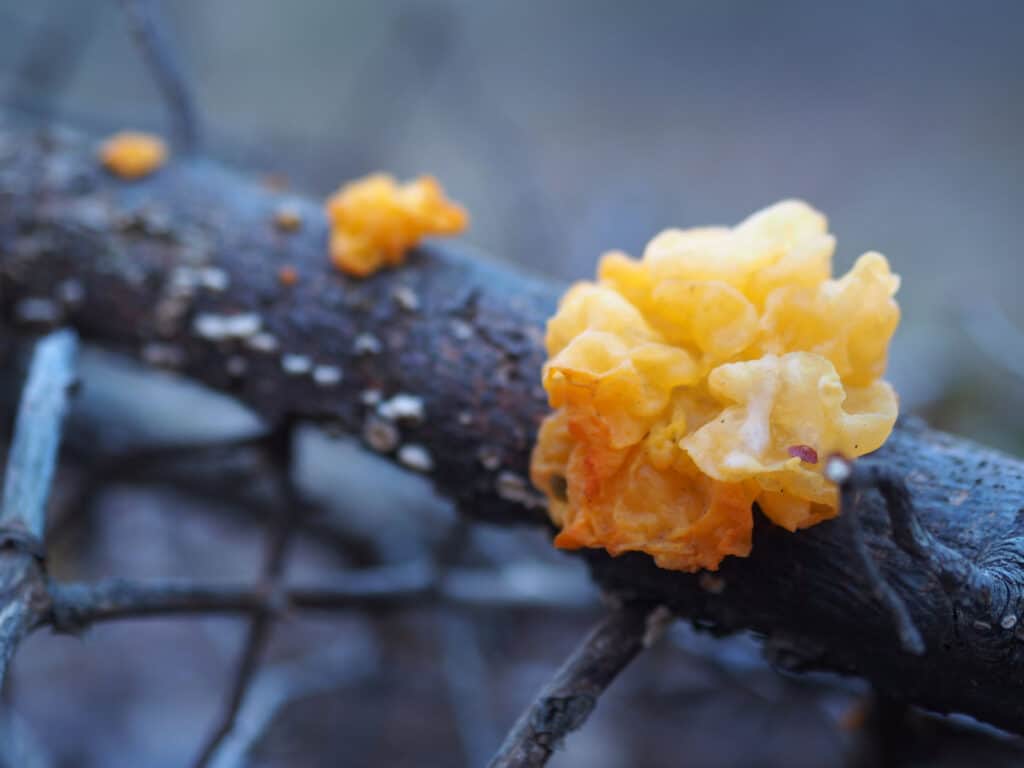
While not exactly the tastiest, witch’s butter (pictured) is still worth harvesting in the winter when not a lot else is around.
©Mhai Little Arts/Shutterstock.com
Tremella mesenterica is the most common mushroom that people call “witch’s butter”, but there are a few others that some people give that name to. While there aren’t many mushrooms you can find year-round, Tremella mersenterica will always appear on hardwood logs. Although it may not taste very good, it is edible and makes for excellent year-round foraging food for survival. Witch’s butter mushrooms are also used medicinally and may have anti-tumor and possibly respiratory condition-treating qualities. You should always cook any mushroom, whether it is wild or farmed, as a general rule.
Witch’s butter mushrooms grow on hardwood trees with the bark still on them and have a yellowish-orange tint. They are parasitic on other crust fungi in the genus Peniophora, although you may not ever see that fungi. They frequently grow on downed hardwoods as a result. If you ever see a very similar-looking mushroom that is parasitic on Stereum it would be Naematelia aurantia and if you ever see something similar that is on conifer it would be Dacrymyces chrysospermus. All of which have equal edibility.
7. Winter Chanterelle Mushrooms
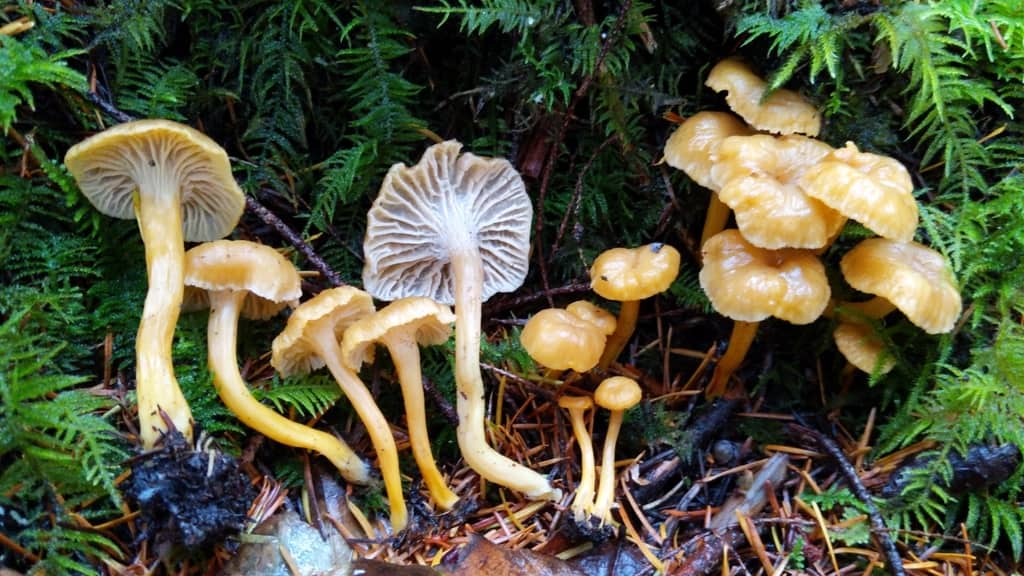
This “winter chanterelle was found in November in Washington state.
©Alan Rockefeller aka alan_rockefeller / CC-BY 4.0 https://creativecommons.org/licenses/by/4.0/ https://www.inaturalist.org/observations/100730827 – Original / License
Winter chanterelle mushrooms are also known as Craterellus tubaeformis. The name “winter chanterelle” may be a little misleading as they normally quit fruiting after the first big snow. The cap of the winter chanterelle mushroom is trumpet-shaped, wrinkled, and has a wavy-curled rim. Its color ranges from ochre to yellowish. The false gills are paler in color than the cap and have large intervals between them. The stem is hollow, somewhat flattened, yellowish or grey on top, and paler below. The entire mushroom has thin meat and a good scent.
Late in the year, from late September to December, is when the winter chanterelle is most frequently seen. Most coniferous forests, ideally those with spruce and mossy forest floors, are where they may be found. Additionally, it can be found in deciduous forests, particularly beech forests, on mossy slopes. The colors of the top merge with the background nearly flawlessly, therefore it should be carefully observed.
The winter chanterelle is a tasty and adaptable edible fungus with a distinctively fruity and spicy aroma. Despite having little flesh, the winter chanterelle is frequently encountered in large quantities, making it exceedingly worthwhile to forage.
8. Birch Polypore Mushrooms
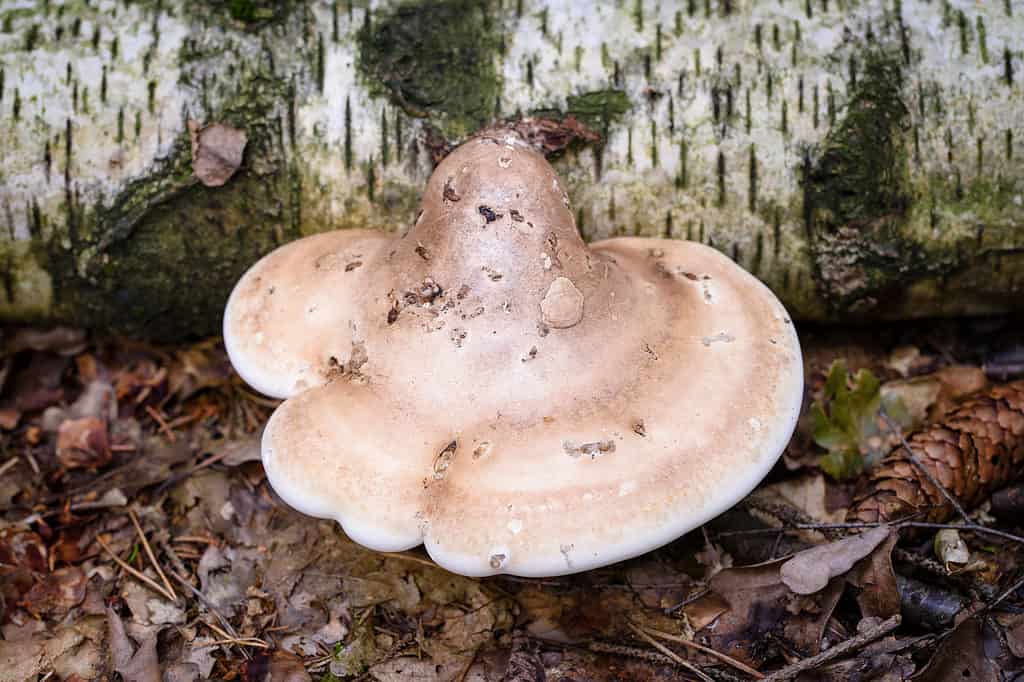
Birch polypore mushrooms (pictured) have a sort of melted ice cream appearance that can make them easy to spot when foraging.
©Milan Vachal/Shutterstock.com
The Birch polypore mushroom aka Fomitopsis betulina, is believed to possibly be therapeutic and has been used by people for this reason for a very long time. The first indications of their use go back over 5,000 years. This easily recognized fungus is widespread anywhere birch trees are found and they grow directly on them. Possibly antibacterial, antiviral, anti-inflammatory, and/or immune-stimulating. These qualities, together make it worthy of an antiseptic and anti-bleeding dressing if you are ever in a pinch. Extracts and tea are also used to try and treat illness.
There are not many toxic polypores out there and the ones that are toxic do not resemble the birch polypore. Birch polypore mushrooms often have a kidney or semi-circular form. They might have no stalk at all or a short, thin stalk that widens before they are directly linked to the tree in certain cases. Their exterior comes in a variety of light-colored colors ranging from white to grey to brown.
9. Turkey-Tail Mushrooms
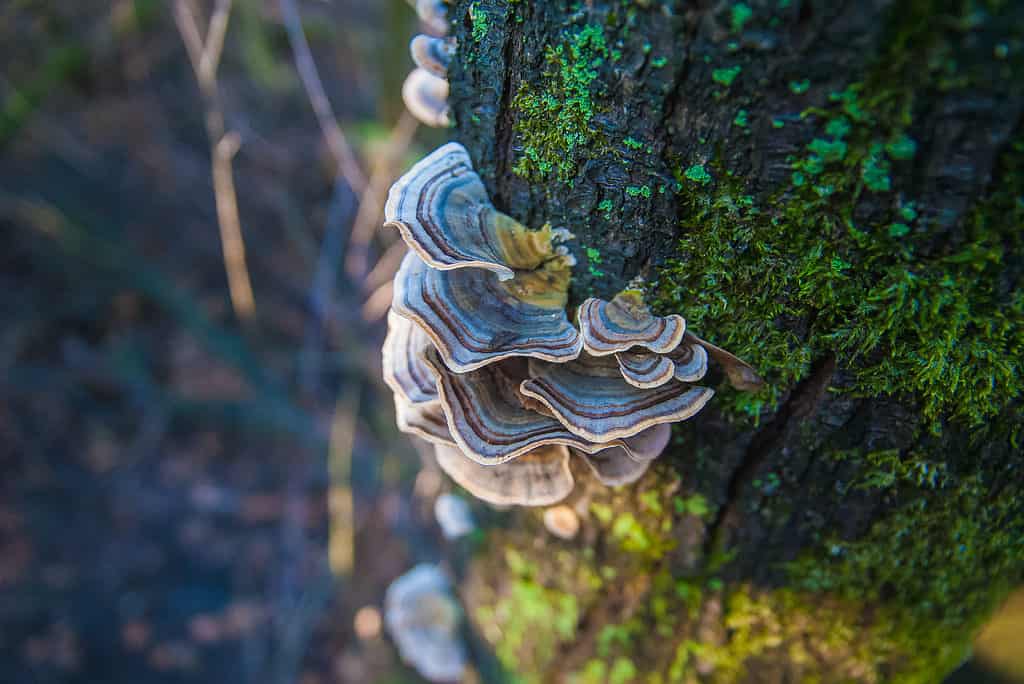
The turkey-tail mushroom (pictured) is very colorful and eye-catching, which is helpful when foraging in the snow.
©Slobodan Cvetkovic/Shutterstock.com
Trametes versicolor aka the tukey-tail mushroom is used by many people to produce sought-after medicinal teas and extracts. They aren’t very suitable for eating directly, due to their disagreeable paper-like texture. In other words, turkey-tail is important for their therapeutic value rather than their quality as food.
The popular name “turkey-tail” comes from the mushroom’s resemblance to a turkey’s tail. The mushroom’s hue is a patchwork of erratic bands of sometimes blues, greys, browns, whites, and blacks, and it fanned out like a male turkey flaunting his plumage in quest of a mate. It develops on dead wood, particularly hardwood, either as rosettes or shelf-like brackets. When it’s new, its texture is rough and pliable, almost resembling leather.
10. Chaga
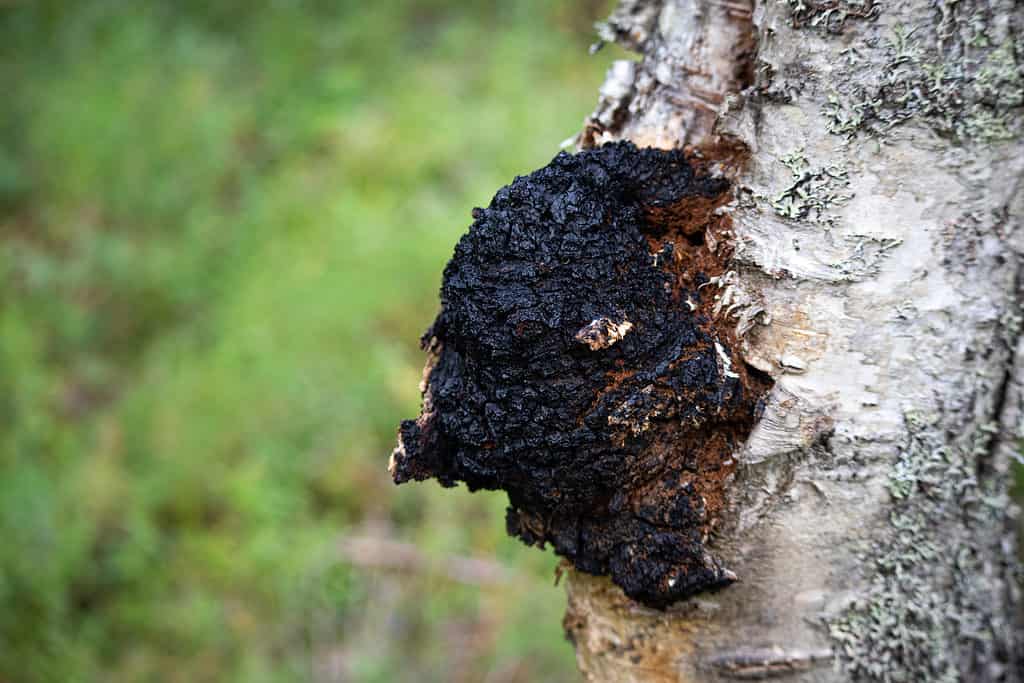
Chaga (pictured) can look more like scorched wood than a mushroom.
©Apatic0/Shutterstock.com
Chaga aka Inonotus obliquus has been used as a traditional wild-harvested treatment for anything from cancer to high blood pressure. Even though they are somewhat widespread is some areas, they still command a premium price in stores and online. When you come across a stand of birch trees, there is a probability that it includes chaga because it is most frequently found on white and yellow birch trees.
The chaga fungus is simple to find and is best collected in the winter when there is no foliage to hide the tree trunks where they grow. The conspicuously black conk shines out beautifully against the white snow and the pale birch tree bark, making chaga mushrooms fairly easy to find.
| Number | Mushroom | Scientific Name |
|---|---|---|
| 1 | Velvet Shank Mushrooms | Flammulina velutipes |
| 2 | Enoki Mushrooms | Flammulina filiformis |
| 3 | Oyster Mushrooms | Pleurotus ostreatus |
| 4 | Brick Cap Mushrooms | Hypholoma lateritium |
| 5 | Wood Ear Mushrooms | Auricularia auricula-judae or Auricularia americana |
| 6 | Witch’s Butter Mushrooms | Tremella mesenterica |
| 7 | Winter Chanterelle Mushrooms | Craterellus tubaeformis |
| 8 | Birch Polypore Mushrooms | Fomitopsis betulina |
| 9 | Turkey-Tail Mushrooms | Trametes versicolor |
| 10 | Chaga | Inonotus obliquus |
The information presented on or through the Website is made available solely for general informational purposes. We do not warrant the accuracy, completeness, or usefulness of this information. Any reliance you place on such information is strictly at your own risk. We disclaim all liability and responsibility arising from any reliance placed on such materials by you or any other visitor to the Website, or by anyone who may be informed of any of its contents. None of the statements or claims on the Website should be taken as medical advice, health advice, or as confirmation that a plant, fungus, or other item is safe for consumption or will provide any health benefits. Anyone considering the health benefits of particular plant, fungus, or other item should first consult with a doctor or other medical professional. The statements made within this Website have not been evaluated by the Food and Drug Administration. These statements are not intended to diagnose, treat, cure or prevent any disease.
Thank you for reading! Have some feedback for us? Contact the AZ Animals editorial team.

